The twenty-first century is a busy time to be alive. Between the internet and our increasingly interconnected world, people often find themselves moving around an awful lot.
Musicians are no different. Between gigs, lessons, collaborating, and countless other things, we often make music all over the place. Because of this, portable merchandise is extremely valuable.
Because MIDI keyboards work with computers, and many computers today are laptops, it makes sense that many are made with portability in mind. Some producers might travel a lot, while others work during their morning commutes.
Top 3 - Smallest MIDI Keyboards
Preview | Product | Price |
|---|---|---|
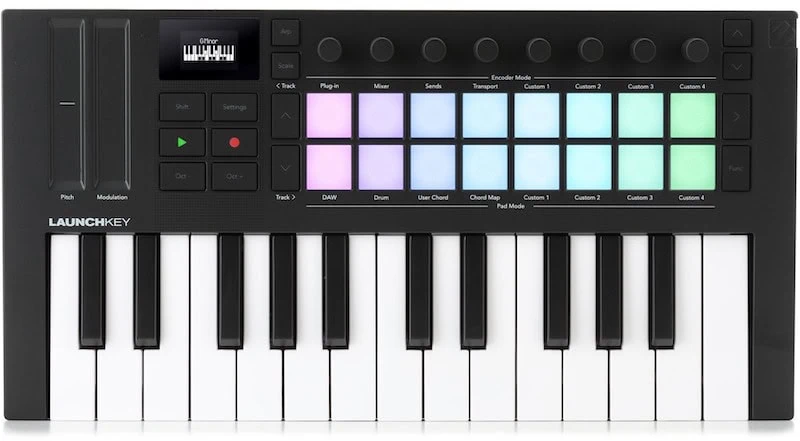 | ||
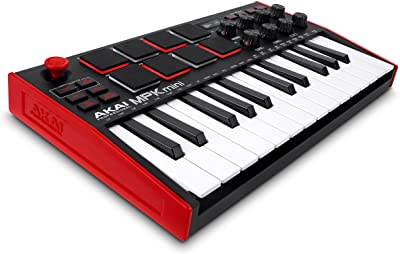 | ||
 |
Whatever your reason may be, below are some of the best portable MIDI keyboards in the market.
Smallest MIDI Keyboards - 7 Compact Controllers
1. Novation Launchkey Mini 25 MK4
I have had the pleasure of testing out multiple Novation products, and I’ve always been impressed with their attention to detail. They have many Launchkey products of various sizes and prices, and each one feels solid and well-designed.
Of the five products in this article, I believe the Launchkey Mini is probably the best 25 key MIDI controller for most people.
Why? It’s simple; the keyboard is extremely lightweight, but still has more customizable options than the rest.
It’s smaller than one square foot, weighs less than two pounds, yet TWENTY-FOUR of its thirty-six buttons are assignable (by “buttons,” I mean anything you press besides keys).
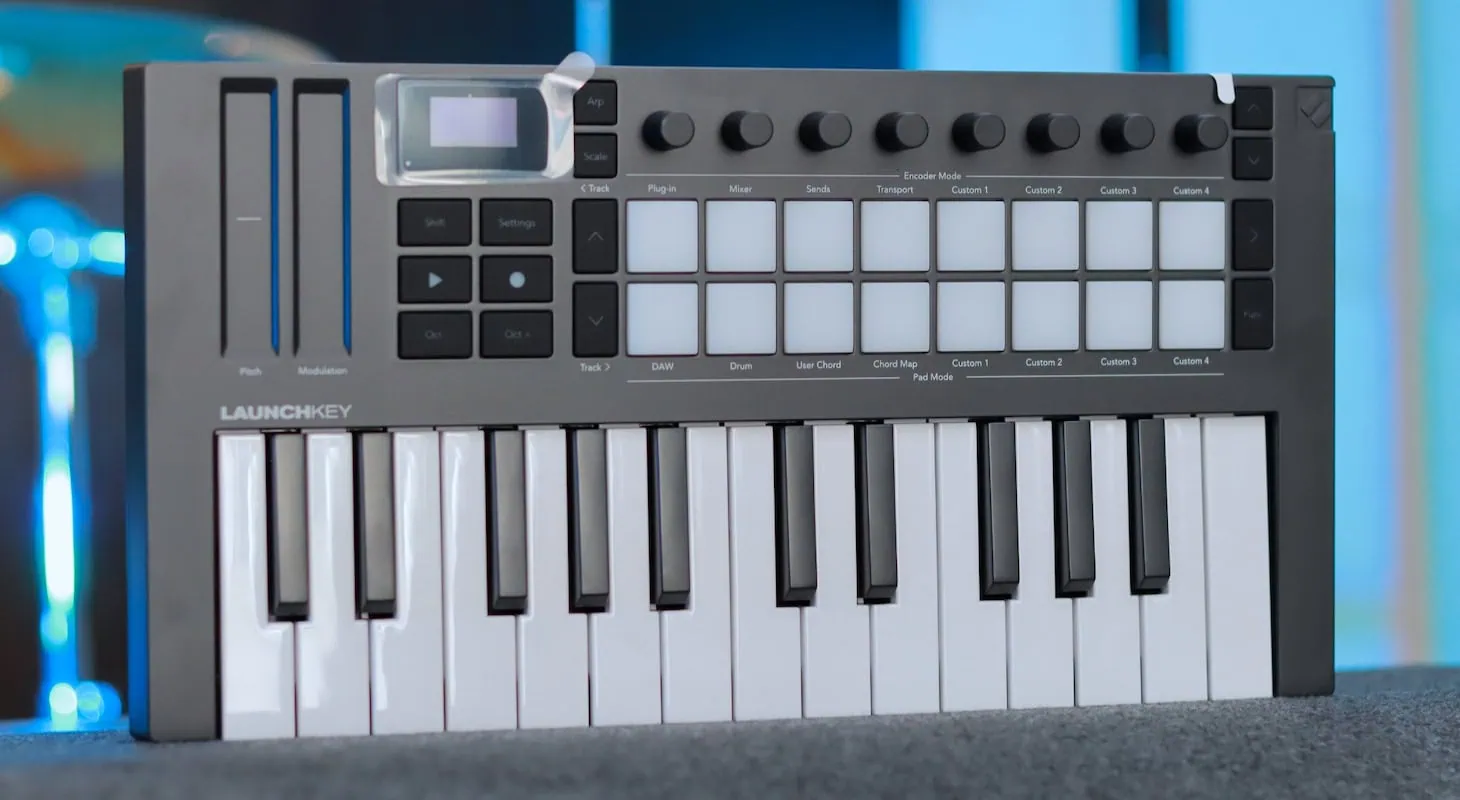
Novation Launchkey Mini 25 MK4 - Closer Look
All sixteen pads feel responsive, while the encoders twist smoothly. And while you can map them however you want, they have default settings if you’re new to MIDI keyboards and just want to start jamming.
Besides its jam-packed and optimized features, I appreciate the Launchkey’s integration with Ableton. While I use Reaper, many of my buddies use Ableton for live performance and studio recording.
Whenever I plug it into my friend’s computer, it’s automatically set up and ready to go. The mapping makes sense, and is easy to understand.
If you use other DAWs though, it’s still simple to set up.
As a synth player primarily, I really love the included touch strips for performing intricate modulation and getting the most out of my soft synths. With traditional wheels for pitch and modulation, your creative options are limited.
With the LaunchKey’s customizable setup, I can create all kinds of filter sweeps, weird LFO-type rhythms, and even tap randomly to make parameters jump in unexpected ways.
I also think that if you're using your laptop remotely, being able to perform volume adjustments on your mixer page is super useful.
I've often left automation for the mix stage and always regretted it. When you're performing with a keyboard controller, you get so many ideas that if you just make a mental note to implement them later, they never get done.
For example, I love gradually bringing in strings and pads so they start silently and build toward the chorus. I can't achieve this naturally with a mouse or trackpad, but with the touch strips, I can perform multiple volume rides simultaneously and get a truly natural performance from both my synths and sample library.
To be fair, I would mention that the keys themselves feel a bit flimsy because of the plastic used to make them. However, if looking for something incredibly lightweight with ample customization, the Launchkey is one of the best mini MIDI keyboards you could buy!
Further reading: our full review of the Launchkey Mini 25 Mk4
2. Akai Professional MPK Mini MK III
Akai is a well-respected and mainstay name in the world of music technology.
Their drum machines revolutionized hip-hop production, and they introduced backlit screens on portable recording devices back in the 1970s!
Admittedly, their keyboards aren’t as renowned as their other products, but they’re by no means bad. Akai’s MPK Mini includes an impressive eight pads and eight encoders, which are all assignable.
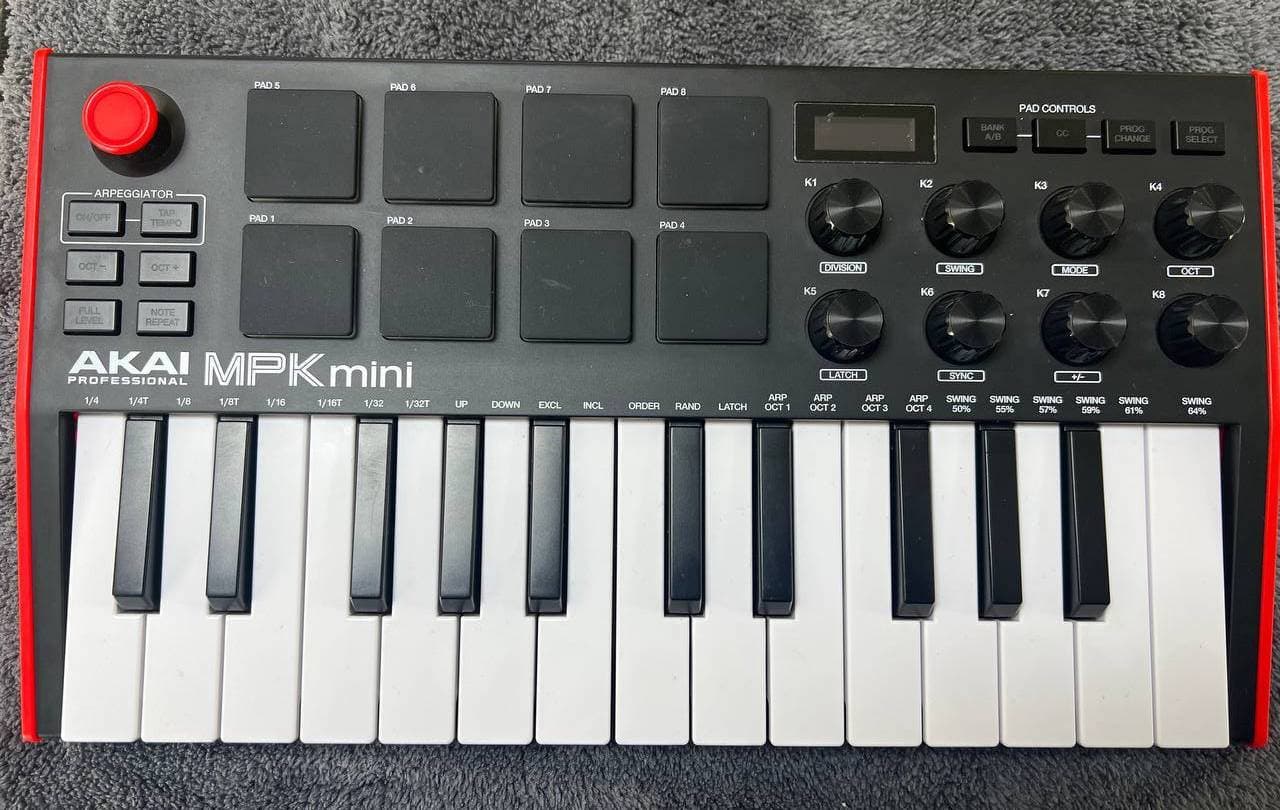
The MPK Mini offers a deeper DAW integration than most of its peers.
While not as numerous as Novation’s Launchkey, its sixteen customizable parameters will be plenty for many. The pads felt sturdy, yet remained incredibly responsive to finger drumming – an expected feature from a company renowned for drum machines.
The pads are also some of the best for programming realistic drum passages with detailed sample libraries like Addictive Drums 2 and BFD3. Most people associate Akai with hip-hop or pop productions where the pads simply act as a drum machine or one-shot sample trigger. However, because they're so musical and sensitive, they actually help you create more realistic drum performances.
I’m always programming kicks and snares on Addictive Drums 2 using these pads and getting the velocity just right. This ensures the snares trigger different samples whether I'm playing them extremely hard, soft, or doing a ghost stroke.
That's the key to creating drums that could fool anyone into thinking it's a real drummer. It’s all about paying attention to those notes between the main hits on two and four.
To achieve this, you need sensitive but balanced pads that don't over-trigger, and the ones on the MPK are the best I've experienced on any small keyboard.
Another feature Akai is awesome at is the swing for their arpeggiators. They're legendary for MIDI timing, and this feature extends to their Mini keyboard as well. I use their arpeggiator with nearly every VST synth in my collection. I even prefer it over the legendary hardware synths I own!
That's how tight and musical it is.
I'll even go as far as creating Groove Templates from the arpeggios to add to Ableton as swing quantizers. It works amazingly well for dance and pop music.
The MPK Mini is slightly bigger than the Launchkey, and twice as heavy. However, it still fit comfortably in my backpack alongside my laptop.
Its software integration was also a plus for me. The included software has 1,500 sounds. As a budget musician I can always hunt down sounds myself, but getting that many sounds at one time definitely saves tons of time.
I thought the MPK Mini integrates with DAW software more smoothly than the Launchkey. I realized that, besides scrolling with my touchpad, I could interact with almost every DAW feature directly through the keyboard itself.
All factors considered, the MPK Mini seems slightly limited compared to the Launchkey. The joystick was also more of a hassle than traditional pitch/mod wheels and strips.
There's a silver lining in using a joystick, though: it adds an extra layer of experimentation for keyboard players.
One of the coolest keyboards ever made was the Sequential Prophet VS. Arturia now offers a great emulation of it. This was the first keyboard to feature a joystick that allowed you to merge four different modulations with a simple movement, creating brand new sonic options.
With the MPK triggering the Arturia emulation in my computer, the joystick is amazing to play with. You can program it to manipulate multiple parameters simultaneously. If you want to go beyond traditional synth pads and obvious electronic sounds, try using the joystick to explore unique and interesting ways to bend your sound.
Because of those factors, I recommend the MPK Mini to people who value deep DAW integration and will use it exclusively on the go.
Read my full review: Akai MPK Mini Mk3
3. Arturia MiniLab 3
MIDI controllers are great, there’s no doubt about that. Even a simple keyboard like the Nektar SE25 instantly makes you feel more connected to your music making.
However, sometimes hooking it up to a computer is a drag. Without that computer, you can’t do anything. I mean, they are called “controllers” for a reason, right?
Enter the Arturia MiniLab 3. It is a controller with all the traditional features. But it can also work alone without a computer!

Arturia MiniLab 3 - not the lightest, but rather probably the sturdiest compact MIDI controller that you can get!
As someone who tries to make music as organically as possible, I always jump on opportunities to record music without a screen. With 500 preloaded samples, I had a heyday experimenting with diverse sounds.
I like how the autonomy of the MiniLab encourages spontaneity. Once it’s in your backpack, you’re prepared to capture sudden ideas of inspiration.
The MiniLab has eight pads, eight encoders, and four faders. They all responded smoothly to manipulation.
When you do plug the MiniLab into a computer, it maps well with DAWs, and comes with excellent software. It has Analog Lab, which includes many sounds emulating my favorite synths like the Minimoog.
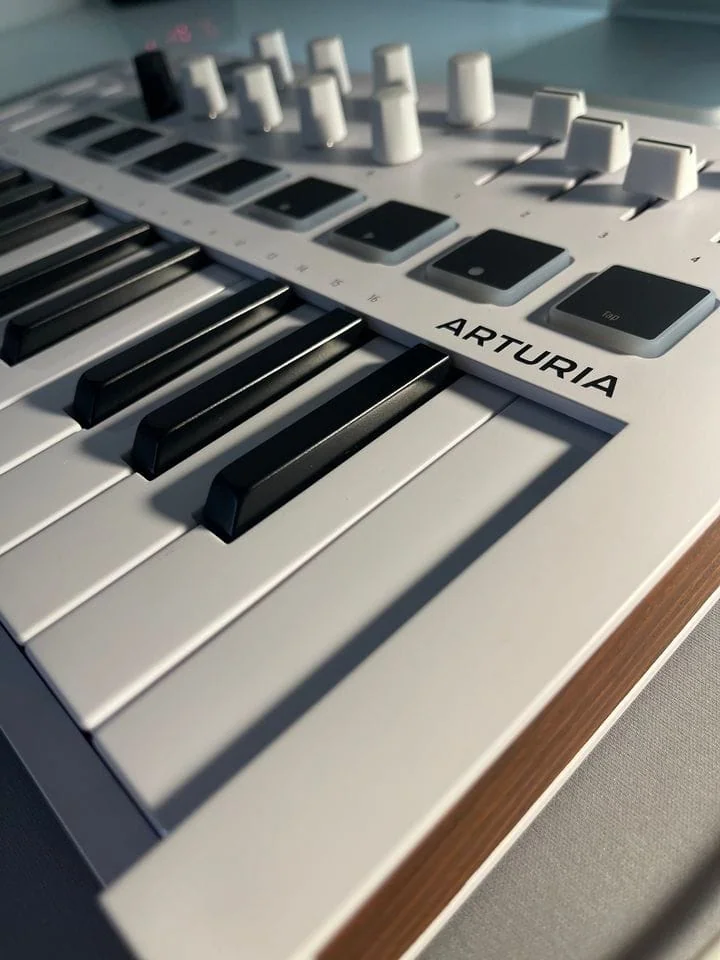
The MiniLab screams quality!
Having faders on such a small format keyboard just shows how professional and premium Arturia is when it comes to creating some of the best controllers. People always associate faders with mixing, but they can be used as performance tools as well.
Also, you don't have to just do volume rides with faders. You can actually customize them to perform a lot of functions. The faders on Roland synthesizers can sweep the filter, cross-modulate different oscillators, and more.
One thing I use faders for a lot is changing envelopes in synthesizers. This is the key to making digital emulations play way more realistic, as if they were analog synths. When you turn down the release on a lot of keyboards, it adds this little clicky percussiveness whenever you lift your hands.
That sound was emulated by the companies that make these emulations, and Arturia is one of the best, so they added it to all their synths. With the faders, when you're playing their emulations like the Jupiter-8 and Juno-60, you really feel like you're manipulating the real hardware.
It adds so much to your performance, and you end up playing better and getting better ideas and takes on your synth tracks.
That's why I usually use the MiniLab for synthesizing electronic music and dance-pop, especially if I'm on the go.
My one complaint about the MiniLab is its weight, which is both a blessing and a curse. As the sturdiest product in this article, it’s around three pounds.
It makes sense that increased durability means increased weight, so it’s a choice you’ll have to make. Overall, its autonomy, faders, and software make the MiniLab one of the best mini MIDI keyboards in the market today.
Further reading: my full review of Arturia MiniLab 3
4. Nektar SE25
Some people want lots of knobs and buttons on their keyboards. Some just need a plain old keyboard.
For those of you in the latter group, the Nektar SE25 is a fantastic find!
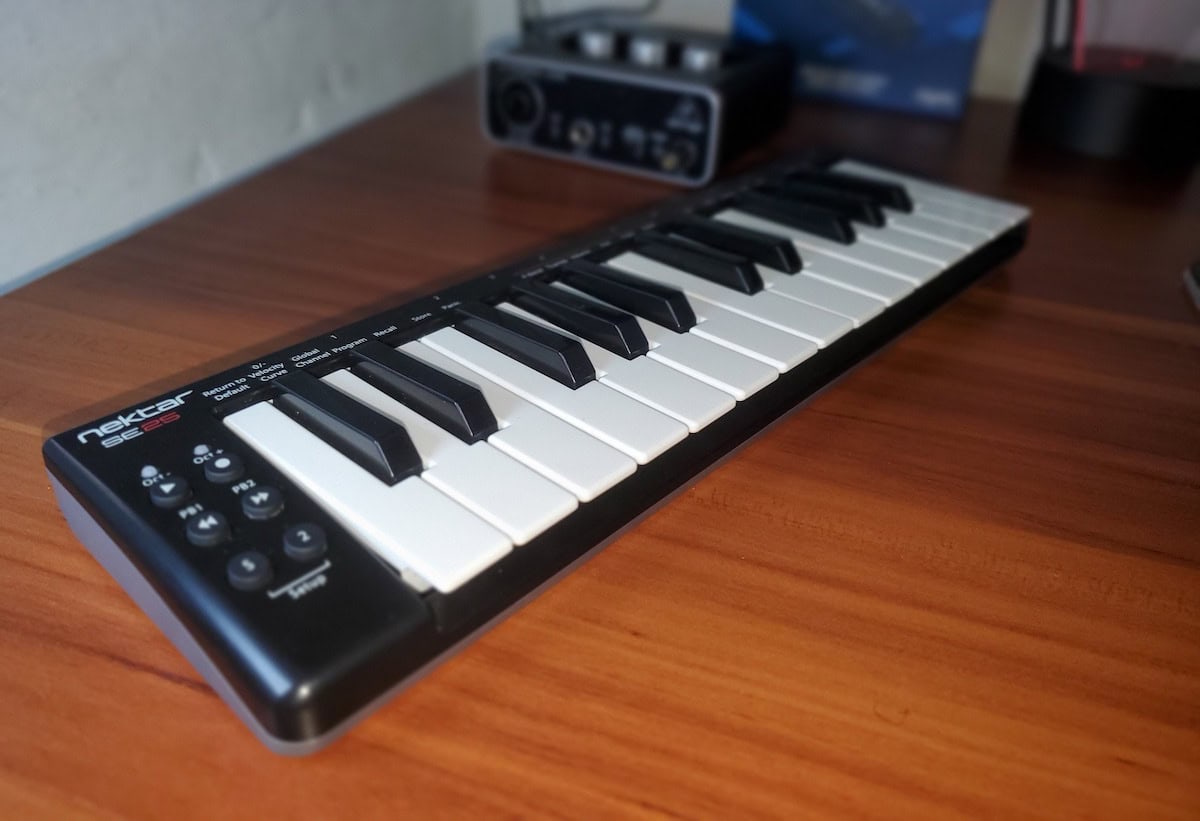
Nektar SE25 - a surprisingly minimal offering!
It’s hard to beat a two-octave keyboard weighing less than a pound! My wife plays flute, and she can squeeze her flute case into anything. This keyboard is even smaller than that!
How did Nektar do this? They forwent encoders and pads completely. For many people that’s a dealbreaker. But as already mentioned, if you’re after a bare-bones keyboard, it’s a perfect match.
Second, they minimized essential settings to six buttons on the left and made each key work as a secondary parameter button.
You know how you can press SHIFT on a computer and enter a new character with the number buttons? The SE25 works the same way; you can press the S key and a corresponding key to select what you need.
Not only do I find this design clever, but it makes changing parameters very fast since everything is within reach without moving your hand. A small detail, but it helps efficiency!
For the purposes it serves, I found the SE25 one of the best portable MIDI keyboards out there. It was easy for me to understand, minimalist, and so efficient I forgot it was even there after a while.
I was also quite surprised that they included two very important features. First, the keys are unbelievably responsive for such a tiny keyboard. When I discussed the AKAI controller and its wonderful pads earlier, I didn't mention that for hihat work, I prefer very responsive synthesizer-style keys.
The reason is simple: the snap of a key helps you groove better when playing hihats, especially with multi-sampled libraries like those I mentioned before. I'm not talking about playing hip-hop or pop-style loop dance hihats. I mean simulating a drumstick hitting a hihat to create realistic, detailed sounds.
These keys are super snappy and tight, with no lag between pressing and releasing. This responsiveness is particularly helpful for up-tempo music like EDM and Pop. Since I produce many remixes, especially while DJing on the road, this little keyboard has definitely earned a place in my arsenal.
The second impressive feature is the built-in transport controls. Though tiny and minimal on the left side of the keyboard, they provide the essential tactile feeling of pressing record, play, fast-forward, and rewind.
This might sound like a standard feature, but you'd be surprised. I remember when the only options were those terrible M-Audio controllers with no transport controls at all. While it's becoming more standard now, not every keyboard controller includes them. So kudos to Nektar.
Finally, you can’t beat the price point. Again, if all you need is a highly portable keyboard, the SE25 is well worth consideration.
5. Native Instruments Komplete Kontrol A25
The Komplete Kontrol A25 is a more minimal version of Native Instruments' lineup of what I call composer-centric controllers.
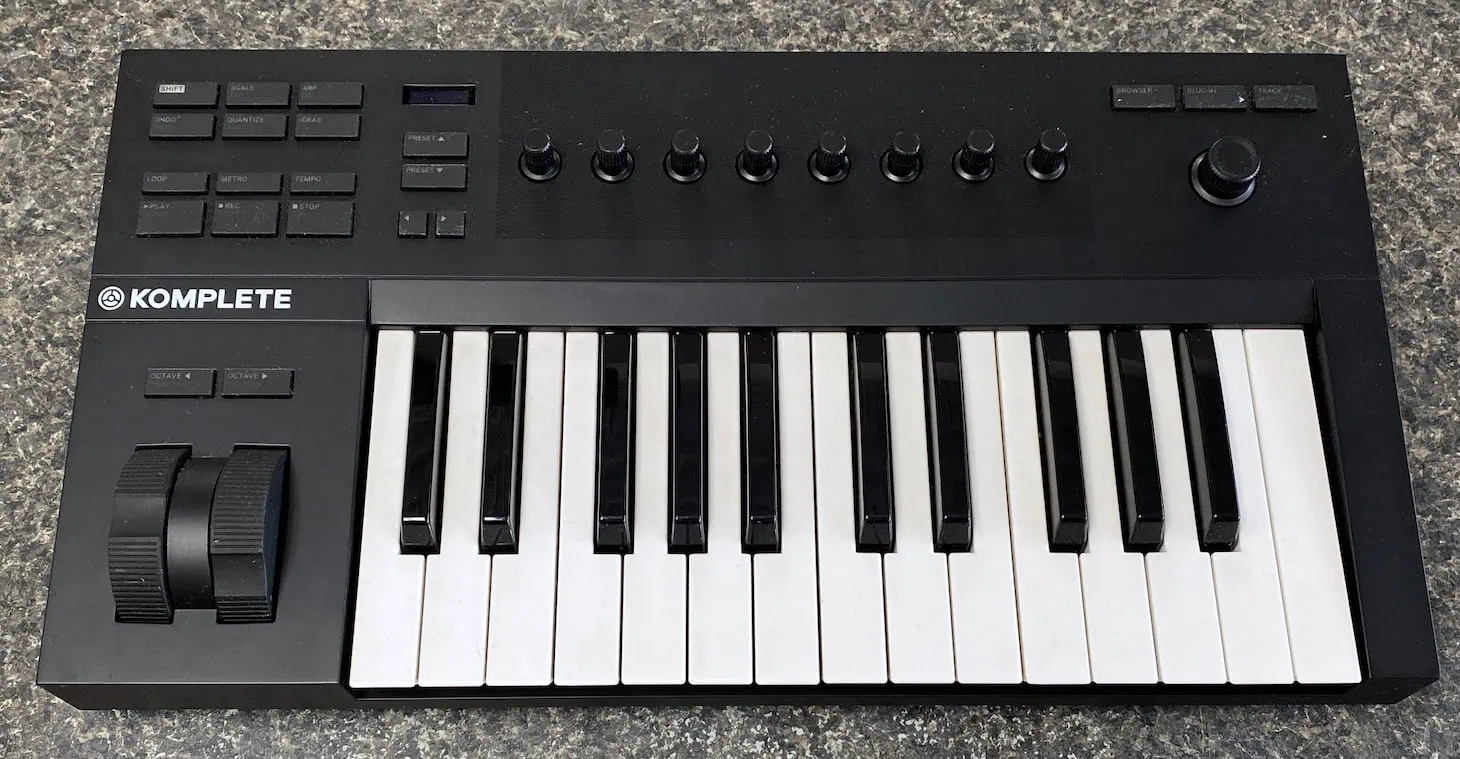
Native Instruments Komplete Kontrol A25
These controllers can be used for any genre to produce many types of tracks. They're designed to work with Native Instruments' ecosystem called Komplete.
The integration of a browser button lets you explore different sounds across their instruments like Absynth, Kontakt, FM8, and many others. If you're a devoted NI user like me, this might be the perfect controller for you.
I use it frequently for Film and TV work where I create genre-bending cinematic pieces. The Native Instruments libraries are unmatched, offering everything from African percussion to ambient digital synths. Essentially anything you might need as a jingle creator, film composer, or producer creating tracks for visual media.
One disappointment with this model is the lack of backlit keys, which are included in their larger controllers starting with the 49-key version.
Perhaps this is because the A25 is designed more as a general controller rather than specifically for composers or film music arrangers.
I still wish they had included backlit keys, but they made their design choices.
Nevertheless, this is a keyboard I'd recommend for songwriters who create complete demos. If you're adding everything from drums to vocals in your productions, this might be the only controller you need in your home studio to record and program everything in your DAW.
I personally use this controller frequently because the keys feel amazing. Since Native Instruments also creates excellent libraries of upright pianos, grand pianos, and various vintage keyboards and organs, they understand that many of their users are keyboardists and have equipped this model with premium keys.
The size and weight seem puzzling for what's marketed as a travel keyboard. However, when incorporating premium features, space is necessary, so I suspect they intended this less as a travel setup and more as a main controller for bedroom producers with limited space.
6. Korg nanoKEY2
The Korg nanoKEY2 looks like some futuristic doomsday machine out of The Matrix! Even if you don’t buy it, you have to admit it looks awesome!
Because of its design, the nanoKEY2 serves a specific function, and that’s to input MIDI notes onto a computer.

Korg nanoKEY2 - connected to my MacBook Pro (M1)
Rather than using traditional keys, the nanoKEY2 uses plastic buttons arranged in two rows emulating black and white keys. At just over half a pound, it’s the lightest portable keyboard on this list. Plus, it’s the second smallest and most inexpensive.
You do have to be careful because it’s not the sturdiest keyboard I’ve tried. The keys are slippery, and reviewers warn they can pop out after months of use (they easily pop back in though).
I found I could still enter chords by playing all notes at once, and play simple melodic lines. It feels different, but since you’re not performing, it works.
Before you say the nanoKEY2 is pointless, hear me out. I think it’s one of the best portable MIDI keyboards for electronic musicians and composers. It doesn’t need to function like a performance machine.
I hung out with composition majors at university, and 99% of the time they just used keyboards to plug notes into Sibelius. The same goes for electronic musicians, who use DAWs similarly.
There are also keyboard players like me who sometimes enjoy the limitations of not thinking like a pianist.
If that sounds weird, hear me out. Sometimes being able to play the piano well can be a curse because it leads to overplaying when you're working outside of genres like jazz and classical.
When I go to studios to work on electronic music, I often start playing intricate jazzy chords, and the artist tells me to simplify because it sounds "too jazzy." I've caught myself doing this frequently, even when I'm alone in my own studio.
Scaling it down to where you can't really overplay on the nanoKEY is actually quite interesting. It makes me play things I normally wouldn't consider. Ideas that might seem childish or ridiculous actually sound really cool when making hip-hop or minimalist techno tracks.
That's why I bought one of these keyboards for when I want to take off my pianist hat and shift into the mindset of step sequencing and minimal production.
There’s more though! If you decide later that you wanted a keyboard with more features, you’re in luck. Korg made other similar products to be used together like a puzzle. They include ones with pads and faders.
At a similar price point, if you play your cards right, you can buy two Korg products for roughly the same price as a full-fledged keyboard (or cheaper). After all, if you’re not going to use all the features on a fancier keyboard, you don’t necessarily need it.
7. M-WAVE 25 Key USB MIDI Keyboard Controller
M-WAVE is a smaller company, so its name isn’t as famous as names like Korg and Arturia. Despite this, their MIDI keyboard is impressive.
M-WAVE’s keyboard has the typical pads and encoders, but its wireless connectivity is its biggest selling point. On the move, less wires could easily make it one of the best portable MIDI keyboards.

M-WAVE 25 Key MIDI Keyboard in Pink
To test out M-WAVE’s versatility, I connected it to my Windows computer, iPad, and Android phone. It worked with all of them using Bluetooth!
Bluetooth is great for more reasons than convenience. Often, in order to produce with iOS devices, users had to buy extra adapters. With built-in Bluetooth, I could avoid that hassle.
I did, however, find connecting to Windows a bit finicky. It was surprisingly difficult given that Windows is the most commonly used OS out there.
To accompany its wireless capabilities, the keyboard runs on batteries. I appreciate that M-WAVE was so dedicated to creating a fully functional wireless product.
I use this keyboard a lot when I'm short on table space, whether it's at another studio or during a night when I'm DJing with multiple DJs and everyone has brought their laptops. I sometimes need the smallest setup possible, and that's when I turn to my iPad and other iOS devices.
When I'm DJing, I always add synthesizer and drum samples on top of my sets, so I've become quite adept at bringing a minimal iOS setup just for triggering the Moog iOS app and GarageBand for additional samples.
The Bluetooth connectivity on the M-WAVE makes it ideal as my little sidecar laptop replacement setup.
So how does a product so focused on unique features measure up with the normal ones?
Fortunately, M-WAVE’s product still shines! Its eight encoders spin infinitely in both directions, and they turned with enough resistance to avoid turning too far. Its pads felt responsive to varying pressures.
The only complaint I have is the feel of the keys. While adequate, they’re a little flimsy, and the black keys slant at an odd angle.
Still, for a company you might not know, they definitely hold their own. Sometimes smaller companies can be a bit sketchy, but that’s not the case here.
Choosing a Portable MIDI Keyboard
Just like many other areas in life, the choices you have to make regarding music gear can be overwhelming. It’s exciting to read about all the features, but after a while it all blurs together into a big confusing mess.
Here are several tips to help you prioritize the features that matter most to you.
Factor 1: Size and Weight
It goes without saying that size and weight are some of the most important factors for a portable device. But how exactly do we decide what size and weight to look for?
First, understand that even though size and weight are important, compatibility with your computer and musical needs is more important. A pound of difference won’t matter if you want to trigger samples but don’t have any pads.
Second, consider what you’re using to transport it. Is it a backpack? Maybe a shoulder bag? Is it made of thick fabric or thin plastic? You’ll want to know how big your bag is, as well as a rough estimate of what else is going in it.
Third, if you’re traveling by plane, weight will be extremely important. If you put it in a carry-on or hand luggage, every pound is important. The standard carry-on weight is 15 pounds, and you’d be surprised at how much a single pound can make or break a trip!
Finally, if you're performing live, opt for the most minimal setup possible, as stages are increasingly downsizing and becoming more cramped. Especially for DJs, consider not only lightweight equipment but also battery-powered options like the M-WAVE.
Factor 2: Where Will You Use Your Keyboard?
This may not be as important as the other factors, but it will still influence your decisions. The social and physical surroundings of your environment will dictate how you use your keyboard.
For example, a city bus won’t have a table, but a train will. A public park will have more nosy bystanders than a friend’s backyard. And cities, for all their urban charm, will definitely be dirtier than houses and studios.
Whatever you choose, make sure you’re comfortable using your keyboard wherever you work.
Factor 3: How Will You Use Your Keyboard?
This factor is important for any musical gear in any situation, but the considerations are more focused for portable gear. Because portable gear is smaller and more compact, it is crucial that you know exactly how you intend to use every feature.
For example, if all you care about is plugging notes into a computer, the nanoKEY2 could be just what you need. If you are into sound design and synthesis, however, you will probably want knobs to tweak ADSR and filters.
The same applies to physical faders. If you're an engineer at heart and crave that tactile experience beyond just using knobs, this might narrow your search to specific options like the Arturia Minilab.
Even live performance is important to consider. A two-octave keyboard might not be a good replacement for a full piano, but it certainly has great uses outside a traditional keyboard context.
Whatever you decide, make sure you have accounted for every key, button, encoder, or pad – or lack of them!
Drum pads certainly are one of the distinguishing features across these brands. However, after testing all these keyboards with pads, I found little significant difference in their overall usefulness.
However, when you start feeling their responsiveness, the AKAI MPK is on another level altogether. Especially if you are finger drumming or also programming synths on them.
While basic triggering is possible with any pad-equipped keyboard, if you specifically need realistic, sensitive pad options, your choices narrow down to just a few models.
Factor 4: How is Your Keyboard Laid Out?
Your keyboard’s layout is a subtle thing that can make a big difference. It may not be as obvious as weight or features, but it can still affect how you approach your keyboard.
Every square inch of your keyboard is “prime real estate” for each feature. You want a layout that makes sense to you.
Some people may want the no-nonsense interface of the Alesis MKII, while others may want more labels like the Novation Launchkey. Others might be perfectly happy with the S-button and keys on the Nektar SE25.
Factor 5: How Much Do You Want to Customize?
Lastly, how much will you want to customize your DAW mapping and sounds?
If you have a lot of specific ideas that you want to bring to life, you may want something that is endlessly tweakable. If you’re a hobbyist, on the other hand, you might be perfectly happy with a plug-and-play model where you don’t have to set anything up.
Provided software is another factor to consider, as well as DAW specifications. Certain products, like the Arturia MiniLab, cater to people wanting quality samples. Others, like the Novation Launchkey, are made with Ableton users in mind.
Also keep in mind the importance of manual automation with encoders. Besides being a keyboard player, I am a sound design enthusiast who loves to use guitar pedals and tweak countless knobs on modular synthesizers.
With the vast amount of analog modeled software plug-ins available today, having the ability to perform tactile moves on encoders is crucial for many players—or at least for me.
This is particularly useful because many controllers allow you to customize different layouts for knobs, faders, and touch strips. I use this approach frequently, especially when performing live, because when I change songs on stage using Reaper, I want my controller to automatically adjust its CC controls as well.
There is no right or wrong answers here, but customization is where your production can really shine!
Conclusion
Back in the day, if you wanted to make great sounding music you had to be in a studio. Most of the time, getting in those studios required serious self-hustling and wads of cash.
Nowadays we are living in a golden age of production, where anyone can create music anywhere! Simply by reading this article, you are part of an exciting new future.
Not only can you be a producer, but you can find inspiration working anywhere you want! Hopefully this article gave you useful advice on how to choose a keyboard, and a jumpstart on finding the best portable MIDI keyboards on the market.
Happy searching!



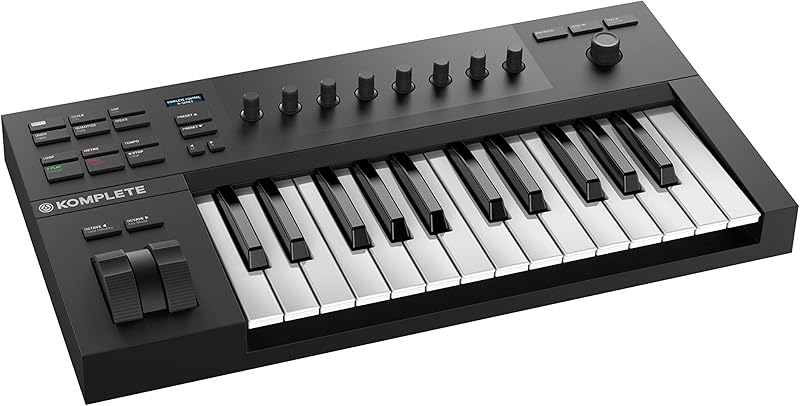

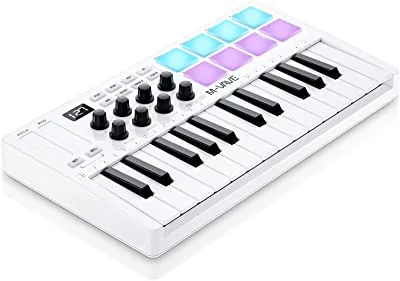
The minilab 3 needs a computer to work….